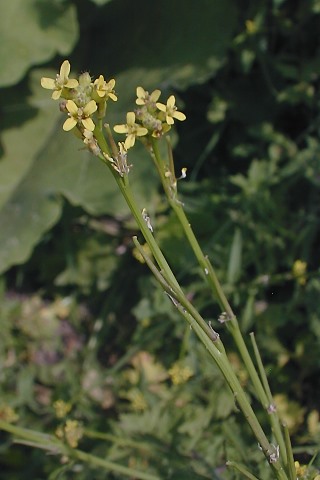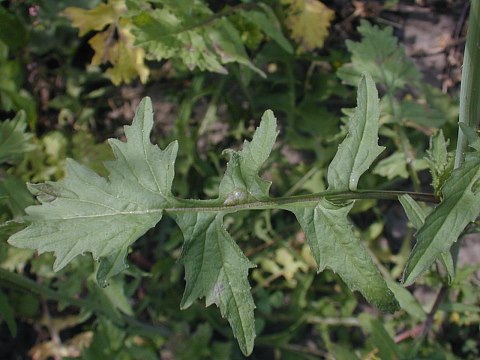Description:
This
annual plant becomes about 1½–3½' tall, branching occasionally
to abundantly. Initially, it forms a low rosette of basal leaves; this
is followed by flowering stalks with alternate leaves. The stems are
light green to purplish green, and usually glaucous; there are
scattered white hairs along the lower stem(s), while the upper stems
are hairless. The basal and lower alternate leaves are up to 8" long
and 2" across; they are pinnatifid with several pairs of narrow lobes.
The upper leaves are up to 4" long and
1½" across; they are divided
into 3 lobes (a terminal lobe and 2 lateral ones) or lanceolate-ovate
in shape. The upper surfaces of these leaves are dull green and
hairless; their margins are irregularly dentate or shallowly cleft. The
basal and lower leaves have long petioles, while the upper leaves have
short petioles
or they are sessile. The upper stems terminate in long slender racemes
of yellow flowers up to 10" long; axillary racemes from the upper
leaves are also produced. The flowers are concentrated toward the apex
of each raceme, while small siliques (narrowly cylindrical seedpods)
develop below. Each flower is a little less than ¼" across; it has 4
yellow petals, 4 green to yellow sepals, a stout central style, and
several stamens. The siliques are less than 2/3" (17 mm.) long and
stiffly erect
or appressed against the central stalk of the raceme; each silique is a
little wider at the base than at the apex. The typical variety of Hedge
Mustard has pubescent siliques, while var. leiocarpum
has glabrous siliques. The pedicels of the siliques are very short
(about 1/8" or 3 mm. long). The blooming period usually occurs during
the summer
for about 2 months; some plants may bloom during the late spring or
fall. Siliques become light brown at maturity; each silique splits in
half to release several seeds. The small seeds are short-cylindrical in
shape, slightly flattened, reddish brown, and about 1 mm. in length.
The root system consists of a taproot. This plant spreads by reseeding
itself.
leaves are up to 4" long and
1½" across; they are divided
into 3 lobes (a terminal lobe and 2 lateral ones) or lanceolate-ovate
in shape. The upper surfaces of these leaves are dull green and
hairless; their margins are irregularly dentate or shallowly cleft. The
basal and lower leaves have long petioles, while the upper leaves have
short petioles
or they are sessile. The upper stems terminate in long slender racemes
of yellow flowers up to 10" long; axillary racemes from the upper
leaves are also produced. The flowers are concentrated toward the apex
of each raceme, while small siliques (narrowly cylindrical seedpods)
develop below. Each flower is a little less than ¼" across; it has 4
yellow petals, 4 green to yellow sepals, a stout central style, and
several stamens. The siliques are less than 2/3" (17 mm.) long and
stiffly erect
or appressed against the central stalk of the raceme; each silique is a
little wider at the base than at the apex. The typical variety of Hedge
Mustard has pubescent siliques, while var. leiocarpum
has glabrous siliques. The pedicels of the siliques are very short
(about 1/8" or 3 mm. long). The blooming period usually occurs during
the summer
for about 2 months; some plants may bloom during the late spring or
fall. Siliques become light brown at maturity; each silique splits in
half to release several seeds. The small seeds are short-cylindrical in
shape, slightly flattened, reddish brown, and about 1 mm. in length.
The root system consists of a taproot. This plant spreads by reseeding
itself.
Cultivation:
The preference is full to partial sun, moist to slightly dry
conditions, and fertile loamy soil with a high level of nitrogen.
However, this weedy plant readily adapts to other kinds of soil,
including those containing clay-loam or rocky material. The fertility
of the soil and moisture conditions influence the size of individual
plants.
Range & Habitat:
Hedge Mustard is common in central and northern Illinois, but it is
less common or absent in the southern section of the state (see Distribution
Map). Of the two varieties of Hedge Mustard, var.
leiocarpum is much more abundant than var.
officinale. Hedge Mustard is originally native to southern
Europe, but it has since spread to Asia, Africa, North America, and
other areas of Europe. Habitats include woodland borders, degraded
meadows, fields and pastures, areas along roads and railroads,
barnyards, poorly maintained gardens, and waste areas. This weedy plant
prefers disturbed areas with fertile soil.
Faunal Associations:
Müller (1873/1883) observed the butterflies Pieris rapae
(Cabbage White) and Pieris napi (Mustard White)
sucking nectar from the flowers of Hedge Mustard; small bees (mainly
Halictid) also visit the flowers to suck nectar and collect pollen. The
caterpillars of the butterflies Pontia protodice
(Checkered White) and Pieris rapae (Cabbage White)
feed on many species of the Mustard family (Brassicaceae); caterpillars
of moths that feed on crucifers include Eustixia pupula
(Spotted Peppergrass Moth), Evergestis pallidata
(Purple-Backed Cabbage Worm), Mamestra configurata
(Bertha Armyworm), Plutella xylostella (Diamondback
Moth), and Trichoplusia ni (Cabbage Looper). Like
other crucifers, Sisymbrium spp. attract various
beetles, including Entomoscelis americana (Red
Turnip Beetle), Phyllotreta cruciferae (Crucifer
Flea Beetle), Phyllotreta striolata (Striped Flea
Beetle), and Psylliodes punctulatus (Hop Flea
Beetle). An insect with a southern distribution, Murgantia
histrionica (Harlequin Bug), sucks plant juices from a wide
variety of crucifers.

Photographic
Location:
The Arboretum of the University of Illinois at Urbana-Champaign. The
photographed plant is var. leiocarpum because its
siliques are glabrous.
Comments:
Hedge Mustard is another weedy member of the Mustard family that has
been introduced from Europe. It produces long narrow racemes with
erect/appressed siliques that are less than 2/3" (17 mm.) in length;
this is one
of its distinctive characteristics. These racemes often curve upward
toward their tips, rather than remaining straight. Other Sisymbrium
spp. in Illinois have siliques that are more widely
spreading; in most areas of the state, these species are less common
than Hedge Mustard.